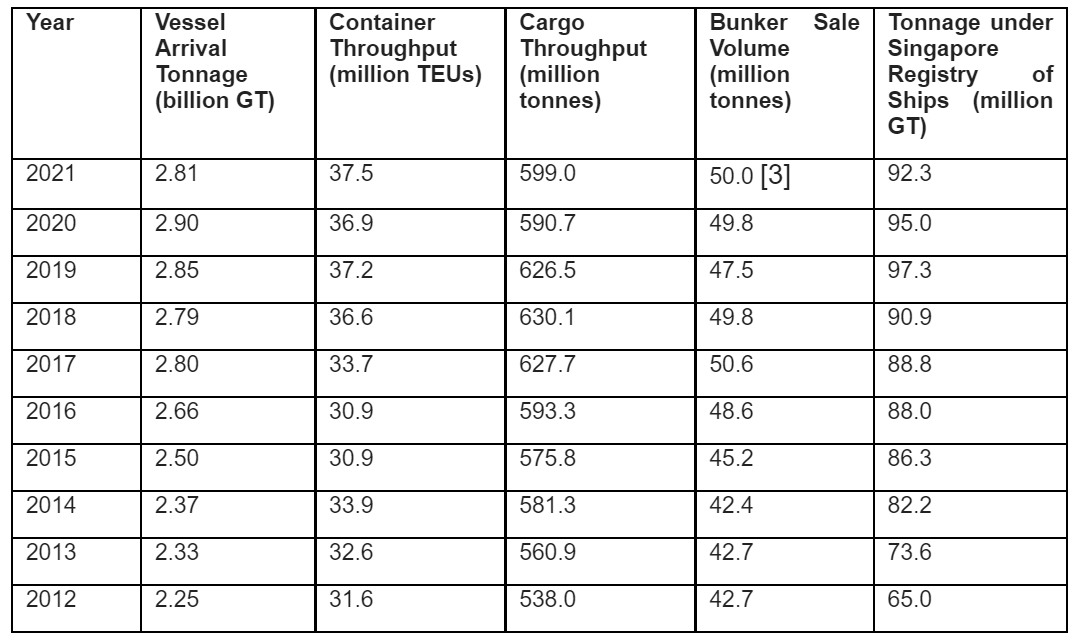Singapore remains the world’s busiest transhipment and bunkering port
The Port of Singapore remained open and connected to the world in 2021 despite the ongoing COVID-19 pandemic. Singapore’s port performance saw a record high container throughput of 37.5 million twenty-foot equivalent units (TEUs). Bunker sales also remained strong, crossing 50 million tonnes for only the second time.
Singapore has also been ranked the top Leading Maritime City of the World for a fifth consecutive time in the international benchmarking study by Norwegian classification society, DNV; and Norwegian consultancy, Menon Economics AS. This is a strong testament of Singapore’s performance in not only the port sector, but also as an international maritime centre in shipping services and maritime technology.
Mr S Iswaran, Minister for Transport and Minister-in-charge of Trade Relations, announced the 2021 performance of the Port of Singapore at the Singapore Maritime Foundation New Year Conversations event today. He also outlined the four thrusts – resilience, digitalisation, decarbonisation and talent – that will guide the government’s efforts to advance the maritime sector and consultations with the industry and unions on the refreshed Sea Transport Industry Transformation Map. “Maritime Singapore has shown itself to be resilient despite the challenges of the pandemic over the past two years. I am confident that the continued strong tripartite partnership between the Government, industry and unions will see us through the recovery phase and allow Maritime Singapore to emerge even stronger.” said Minister Iswaran.
Minister Iswaran also announced that the Maritime and Port Authority of Singapore (MPA) awarded close to S$3 million of funding to 8 projects involving 35 companies working together to accelerate the development of digital products and solutions for the bunkering sector. These projects are part of the first industry transformation map to digitalise the maritime industry, and will support the effort of SGTraDex in data sharing across bunkering stakeholders.
Record-high container throughput; cargo throughput and vessel arrival tonnage remained resilient
Singapore remains the world’s busiest container transhipment port, handling a record high of 37.5 million TEUs of container throughput in 2021. In total, Singapore handled 599.0 million tonnes of cargo in 2021. Vessel arrival reached 2.81 billion gross tonnage (GT).
Strong bunker sales in 2021
Singapore also kept its position as the top bunkering port, registering total bunker sales volume of 50.04 million tonnes in 2021. This comprised 49.99 million tonnes in conventional bunkers sales and 0.05 million tonnes in LNG[2] bunker sales. Singapore commenced regular ship-to-ship LNG bunkering operations from March 2021 and will continue to diversify our fuel offerings in line with our push for maritime decarbonisation.
Singapore Registry of Ships amongst top registries
The Singapore Registry of Ships continued to rank amongst top ship registries globally, reflecting Singapore’s reputation as a quality flag of choice for international ship owners. The total tonnage of ships under the Singapore flag stood at 92.3 million GT, as of December 2021.
Details of Singapore’s maritime performance from 2012 to 2021 are listed below:

About the Maritime and Port Authority of Singapore (MPA)
The Maritime and Port Authority of Singapore (MPA) was established on 2 February 1996, with the mission to develop Singapore as a premier global hub port and international maritime centre (IMC), and to advance and safeguard Singapore's strategic maritime interests. MPA is the driving force behind Singapore's port and maritime development, taking on the roles of Port Authority, Port Regulator, Port Planner, IMC Champion, and National Maritime Representative. MPA partners the industry and other agencies to enhance safety, security and environmental protection in our port waters, facilitate port operations and growth, expand the cluster of maritime ancillary services, and promote maritime R&D and manpower development.



